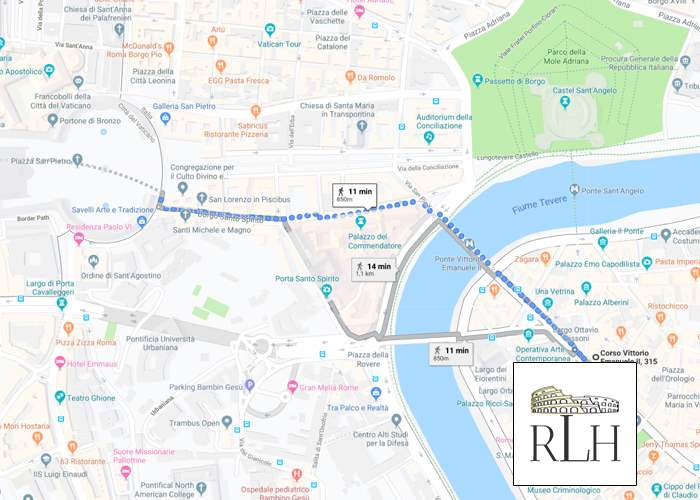Basilica of Saint Peter and Vatican Museums
- by admin admin
- 2 dic 2019
- 3859 Views
The Basilica of Saint Peter in the Vatican rises in the place where, according to tradition, the apostle Peter suffered martyrdom and was buried in 64 AD. Below the area there is the previously pagan necropolis where Peter himself was buried, and nearby the Christians began to be buried. In 160 AD in this place a double aedicule was built to honor the saint, who immediately became a pilgrimage destination.
And it is above the aedicule that the emperor Constantine, converted to Christianity, in 318 AD builds a large basilica in honor of the apostle St. Peter, known as the Constantinian Basilica. The plan was a Latin cross with 5 naves, and the altar was placed in correspondence with the underlying Tomb of Peter.
Due to the state of neglect of the Basilica, in 1506 Pope Giulio II entrusted Bramante with the project for a new Basilica, which would replace the previous one. The Pope wanted a church with a Greek cross plan surmounted by a huge dome at the tomb of the Saint, along with four smaller domes and four bell towers at the corners. Antonio da Sangallo, Carlo Maderno and Gian Lorenzo Bernini collaborated in the construction of the church.
The project then passed to Michelangelo, who eliminated the bell towers. When even Michelangelo died the dome was finished by Giacomo Della Porta and the entire work was completed in 1626. The facade is articulated by giant order columns and surmounted by statues depicting Jesus and eleven apostles (without Saint Peter). Under the facade develops the arcade and 5 doors that allow access to the Basilica. The rightmost door is the bronze Holy Door (made by Vico Consorti in 1950, donated to Pope Pius XII).
In 1667 Bernini completed the arrangement of the area in front: the oval-based area was enveloped by a colonnade of Doric order in trabeation-shaped porphyry and removed from the facade with the insertion of a straight square with a trapezoidal shape, which gave an illusion perspective of depth and balance between the forms. In the colonnade the columns are radially arranged in rows of 4 for a total of 284 columns which progressively increase in diameter, to keep the proportions unchanged with the rows of more external columns.
Inside the Basilica of Saint Peter there are unique masterpieces, many of which by Bernini.
- The Chair of St. Peter is located in the apse and was designed by Bernini between 1656 and 1665. The work represents a wooden throne that preserves a 9th-century artifact, donated in 875 by the king of the Franks Carlo il Calvo to Pope John VIII. Four bronze statues depicting doctors of the church hold up the chair. Above the throne a sunburst of golden stuccoes surrounded by angels and in the center an oval of leaded glass depicting a dove, symbol of the Holy Spirit.
- At the center of the Basilica is the Papal Altarpiece built by Bernini between 1624 and 1633. The work is born from the fusion of the ancient bronzes of the Pantheon and is characterized by twisted columns, 11 meters high.
- The Pietà by Michelangelo (1497-1499) is preserved in the right aisle. The work suggests a great elegance and artistic refinement, given by the softness of the movements, above all of the Christ, devoid of tensions, lying on the knees of a very young and symbolic Maria.
The Vatican Museums were founded by Pope Julius II in the sixteenth century, occupy much of the vast Belvedere courtyard and are one of the largest art collections in the world.
Absolutely not to be missed
- The Laocoonte Group: the sculpture that laid the foundations for the construction of the museum depicts Laocoon and his sons squeezed between the coils of a sea snake.
- Papal apartments with rooms frescoed by Raphael.
- The pinion of the cone courtyard: this bronze sculpture is about 4 meters from the 2nd century AD it must have once been a colossal fountain.
- The Sistine Chapel: built by Pope Sixtus IV in 1475, it was decorated by some of the greatest artists of the time including Ghirlandaio, Perugino, Signorelli, Botticelli and Pinturicchio. However, it is famous for Michelangelo's Last Judgment, considered the masterpiece of the Renaissance
- The torso of the Belvedere: it is a piece of headless statue, without arms and without legs, autographed by the Greek sculptor Apollonius of Athens. Among the most accepted and currently accepted hypotheses, there is one that would identify him with Aiace Telamonio, the Greek hero narrated in the Iliad.
- The Sant’Elena sarcophagus: the sarcophagus, found in the imperial mausoleum at Tor Pignattara, is totally in red porphyry with sculptures that adorn it.
- The Pinacoteca of the Vatican Museums: contains beautiful masterpieces, such as Raphael's Transfiguration, the attributed Stefanesco Polyptych by Giotto, works by Guercino, Caravaggio, Veronese, Leonardo, Guido Reni, Perugino, Beato Angelico, Filippo Lippi and Bellini.
- The gallery of maps: this gallery built at the end of the 16th century constitutes a very precious document of geographic knowledge of the sixteenth century. Many cards are depicted as if they were seen from Rome, and therefore the maps are reversed for the modern observer.





